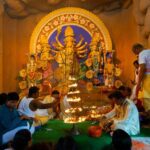Navratri is an auspicious time when the nine forms of Goddess Durga are worshipped with great reverence by devotees across the world. However, did you know that the cult of Shakti might be much older than the Hindu religion? Here we share an excerpt from the new book ‘Mata Vaishno Devi: The Bhakti of Shakti’ which explains this idea in greater detail. As the title suggests, the book not only explores the myths and legends related to Mata Vaishno Devi temple and Goddess Durga, but also acts as a complete guide to the holy place.
Exploring the Ancient History of Shakti Worship
The roots of Shakti worship date back millennia
The history of the cult of Shakti is as old, if not older, than Hinduism. While the origins are not clear, it has been reported that the worship of Shakti or Mahadevi has been going on in the subcontinent for the last 8,000 years.
The Cult of Shakti: A Pre-Hindu Tradition
Shakti worship predates the advent of Hinduism
Thus, the cult of Shakti is, in some ways, the original religion of India and was primarily practised by the tribals inhabiting the subcontinent prior to the arrival of farmers. Once the first farmers in India arrived in Mehrgarh, which was one of the earliest sites of occupation of the Indus Valley Civilization, this school of thought and tradition was adopted by them. It was adopted by subsequent settlements in the following centuries. There is evidence of worship of the feminine and the early beginnings of a cult of Shakti present throughout the territory covered by the Indus Valley Civilization. The Indus Valley period is also the first time that the presence of other sacred symbols, such as the yoni, started and spread throughout the subcontinent.
Shakti Worship Across Ages
The enduring legacy of Devi and Shakti
After the fall of the Indus Valley Civilization, the worship of Devi and Shakti continued even with the arrival of the Vedic Age. The Vedic Age brought about a new pantheon of gods, and in this pantheon, the devis belonging to the Cult of Shakti found their place. This was the period when Shaktism became codified, as the Vedic Age also brought with it writing and texts that were written to formulate rituals and ceremonies. The most important of the female deities mentioned in the Vedas is Ushas. A number of hymns in the Vedas are dedicated exclusively to her. The three Divine Mothers mentioned in the Rig Veda who birthed the Vedic gods are Aditi, Prithvi and Saraswati. Prithvi continued to exist in later Hinduism as Bhudevi (goddess of the earth).
The All-Encompassing Devi
Devi as the embodiment of all
The historically recurring theme of the Devi being all-encompassing arises for the first time in such declarations as this one in the first book of the Rig Veda: ‘Aditi is the sky, Aditi is the air, Aditi is all gods… Aditi is the mother, the father and the son. Aditi is whatever shall be born.’
Goddesses in Vedic Texts
Goddesses like Vac and Shri in Vedic hymns
Also significant is the appearance of two of Hinduism’s most widely known and beloved goddesses in the famous hymn from the Rig Veda: Vac, identified with the present-day Saraswati; and Shri, better known today as Lakshmi. In the hymn, still recited by thousands of Hindus each day, the goddess unambiguously declares:
“I am the Sovereign Queen; the treasury of all treasures; the chief of all objects of worship; whose all-pervading Self manifests all gods and goddesses; whose birthplace is in the midst of the causal waters; who in breathing forth gives birth to all created worlds, and yet extends beyond them, so vast am I in greatness.” (Mandala X)
Shakti in the Kena Upanishad
Early tales of Devi as shakti
The great Kena Upanishad (c. 750–500 BCE) tells an early tale in which the Devi appears as shakti, or essential power, of the supreme brahman. It begins with the Vedic trinity of Agni, Vayu, and Indra boasting and posturing in the flush of a recent victory over a demon hoard, until they suddenly find themselves bereft of divine power in the presence of a mysterious yaksha or forest spirit. When Indra tries to approach and question the yaksha, it disappears, replaced by the Devi in the form of a well-adorned yakshini:
“It was Uma, the daughter of Himavat. Indra said to her, ‘Who was that yaksha?’ She replied, ‘It is brahman. It is only through the victory of brahman that you have thus become great.’ After that, Indra and the devas realized the Truth … having known brahman through such direct experience.” (Kena Upanishad III)
The Enduring Legacy of Shakti Worship
Shakti worship’s continuity and significance
Therefore, Shakti is present throughout most of the foundational texts of Vedic Hinduism as well as in other literary creations of the late Vedic period. While there is no presence of a Shakti Devi in the Ramayana, she is mentioned prominently in the Mahabharata in the form of Durga, with her residence in the Vindhyas, reiterating that the cult of Shakti first existed among the tribal groups of India.
The Coexistence of Male and Female Deities in India
The harmonious balance of male and female deities
In time and with the rise of violence-prone and patriarchal societies, the female deities have been replaced by male deities across the world. But in India, this did not change much. Male gods in India have always existed alongside female deities, and even though they have acquired more prominence lately, our female goddesses have not been ignored as a result of this. They continue to be honoured and respected on their own merit and as graceful consorts of male deities— Parvati as Shiva’s consort, Lakshmi as Vishnu’s and Saraswati as Brahma’s. Additionally, powerful goddesses like Durga and Kali have largely kept their independent status; they are revered and popular even today.







